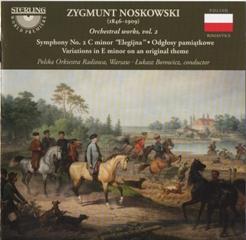Noskowski - Orchestral Works Vol. 2 (2011)
Noskowski - Orchestral Works Vol. 2 (2011)

Symphony No.2 in C minor "Elegijna" 1. Moderato Misterioso 2. Scherzo. Vivace 3. Elegie. Andante 4. Finale. Poco Adagio - Allegro Assai Vivace Odgłosy pamiątkowe (Commemorative sounds) 5. Polacca Maestoso 6. Moderato Cantabile 7. Andante Cantabile 8. Moderato Marciale 9. Molto Moderato 10. Piano Concerto No. 1 in C Minor, Op. 35 11. Poco Allegro Variations in E minor on an original theme 12. Moderato Tranquillo 13. Variation 1: L'istesse Tempo 14. Variation 2: L'istesso Tempo 15. Variation 3: Risoluto 16. Variation 4: Allegro Scherzando 17. Variation 5: Tranquillo 18. Finale. Allegro Animato Polish Radio Orchestra, Warsaw Lukasz Borowicz – conductor
Volume 2 starts with the four-movement Elegiac Symphony which is part Brahmsian-heroic and part Tchaikovskian passionate. There's a Furiant-inflected scherzo which again suggests the pictorial symphonic caste found in Beethoven's Pastoral or the headily whooping Dvořák scherzos. The elegiac third movement moves from funeral cortège (inevitably recalling Elgar 1 or Polonia) to Tchaikovskian fury with a bite of resentment and revenge. The finale is gaunt and scores deep and ragged channels across the firmament before launching a heroic charge. This rises to a victorious hymn. The writing has vitality which is picked up on by an orchestra playing as if possessed by the urgency of discovery. The only tarnish is the closing gesture which is tarred with convention. The writing otherwise has a sufficiency of freshness. The performance has fire to make it well worth your exploration. It is superbly recorded.
The Commemorative Sounds Suite is in seven movements. These very short miniatures traverse nationalist glory, sentimental hymns, sprightly humour, honeyed intimacies, nodding plumes and military pride. The whole thing is over in the space of a concert overture.
The Variations on an Original Theme comprise a theme and seven little variations, each shorter than the movements of Commemorative Sounds. Boredom never enters in. The movements are variously serenely Brahmsian in the manner of the St. Anthony Variations or Academic Festival Overture. At the close there's a bold resolution and staunchly calling brass bring things to a resounding conclusion. --- Rob Barnett, musicweb-international.com
Maybe I'm just getting easy but this symphony had the same refreshing and invigorating impact as our cover item two months ago, Dohnanyi's youthful symphony. Written between 1875-79, it is a response to the failed anti-Czarist January Uprising of 1863 (when you're Polish and you don't have a country, 12 years is like yesterday). Although the notes suggest that a somber, minor-key atmosphere is the dominant element, the cut-and-thrust of the outer movements (the finale ending optimistically with a quotation from the Polish "national anthem") is riveting and vitalizing while the second movement scherzo, in krakowiak rhythm, is a close cousin to Dvorák's and Brahms' national dances and the third movement Elegy is solemn without being despairing. The couplings are short: an 11-minute set of Commemorative Sounds (1904-05) being four popular Polish songs and two other ones of uncertain origin, colorfully orchestrated, and an early (before 1883, possible much before) eight-minute set of variations.--- recordsinternational.com
download (mp3 @320 kbs):
yandex 4shared mega mediafire cloudmailru uplea ge.tt








